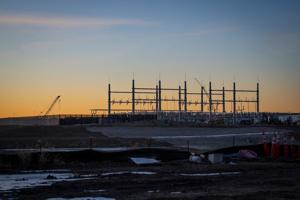Science
Data Centers: Paving the Way for Economic Growth in Rural Areas

The role of data centers in shaping local economies is gaining increased attention as communities recognize their potential to drive growth. While media coverage often portrays these facilities as energy-consuming behemoths, a deeper understanding reveals their significance as economic catalysts, particularly in rural areas.
Understanding Data Centers
Data centers are essential components of the modern digital landscape. They house the servers that power everyday online activities, from searching for recipes to accessing cloud storage. When users interact with applications or services, they rely on a vast network of data centers that process and deliver information almost instantaneously. This infrastructure is crucial for a wide array of sectors, including healthcare, finance, and entertainment, making data centers vital for today’s economy.
Rural America stands to benefit significantly from the ongoing expansion of data centers. These facilities require ample space while remaining close to metropolitan areas to minimize latency—the delay in processing requests. As a result, many projects are located just outside urban centers, allowing them to take advantage of affordable land while still being accessible to large markets. For rural counties that historically depended on agriculture or resource extraction, data centers offer a promising source of new tax revenue and enhanced local infrastructure investment.
Economic Impact and Job Creation
Although data centers do not generate as many onsite jobs as traditional manufacturing plants, their economic impact is substantial. The value derived from these centers extends beyond immediate employment. They support a variety of jobs in related fields such as cybersecurity, logistics, and construction. In essence, each data center contributes to a wider network of employment opportunities across different sectors.
The fiscal benefits of data centers can be impressive. According to recent data, facilities in Loudoun County, Virginia, generate $26 in taxes for every $1 they require in public services. Such returns can significantly bolster funding for local schools and infrastructure projects, providing communities with the resources they need to thrive.
Misunderstandings often arise when comparing the resource consumption of data centers to that of residential homes. Such comparisons can be misleading, as they do not account for the inherent differences between industrial and residential usage. For instance, projections from the Department of Energy indicate that data centers could triple their electricity use by 2028. Even under this scenario, their water consumption would equate to only 1 percent of total corn irrigation in the United States. Furthermore, data center companies are increasingly committing to sustainable practices, including replenishing water resources.
As demands for energy grow, technology firms have been proactive in enhancing local energy generation capabilities. In a notable example, Microsoft has invested in both natural gas facilities and regional wind farms to ensure reliability while tapping into abundant renewable energy sources. Such partnerships not only bolster local grids but also align with broader sustainability goals.
The reality is that data centers play a foundational role in our increasingly digital economy. They are not merely serving the tech sector; they support vital services that impact daily life. For communities evaluating their economic future, welcoming a data center can be a strategic move towards building the infrastructure needed for sustained growth.
Local leaders now face a crucial decision: whether to embrace this opportunity and ensure that their communities reap the benefits of the data center boom. With the potential for job creation, increased tax revenue, and enhanced public services, the future may well depend on how communities respond to this evolving landscape.
Josh T. Smith, the Energy Policy Lead for the Abundance Institute, emphasizes that the economic advantages of data centers extend far beyond immediate job creation. As the coauthor of a guide to data centers released in July 2023, he advocates for a proactive approach to leveraging these facilities for community development.
For communities considering their economic trajectory, the choice to welcome data centers could define their path toward a more resilient and prosperous future.
-

 Technology5 months ago
Technology5 months agoDiscover the Top 10 Calorie Counting Apps of 2025
-

 Health2 months ago
Health2 months agoBella Hadid Shares Health Update After Treatment for Lyme Disease
-

 Health3 months ago
Health3 months agoErin Bates Shares Recovery Update Following Sepsis Complications
-

 Technology4 months ago
Technology4 months agoDiscover How to Reverse Image Search Using ChatGPT Effortlessly
-

 Technology1 month ago
Technology1 month agoDiscover 2025’s Top GPUs for Exceptional 4K Gaming Performance
-

 Technology2 months ago
Technology2 months agoElectric Moto Influencer Surronster Arrested in Tijuana
-

 Technology5 months ago
Technology5 months agoMeta Initiates $60B AI Data Center Expansion, Starting in Ohio
-

 Technology5 months ago
Technology5 months agoRecovering a Suspended TikTok Account: A Step-by-Step Guide
-

 Health4 months ago
Health4 months agoTested: Rab Firewall Mountain Jacket Survives Harsh Conditions
-

 Lifestyle5 months ago
Lifestyle5 months agoBelton Family Reunites After Daughter Survives Hill Country Floods
-

 Technology4 months ago
Technology4 months agoHarmonic Launches AI Chatbot App to Transform Mathematical Reasoning
-

 Technology3 months ago
Technology3 months agoUncovering the Top Five Most Challenging Motorcycles to Ride





















